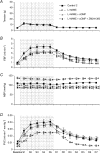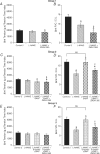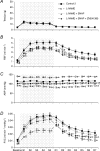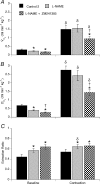Nitric oxide (NO) does not contribute to the generation or action of adenosine during exercise hyperaemia in rat hindlimb
- PMID: 19204054
- PMCID: PMC2678227
- DOI: 10.1113/jphysiol.2008.163691
Nitric oxide (NO) does not contribute to the generation or action of adenosine during exercise hyperaemia in rat hindlimb
Abstract
Exercise hyperaemia is partly mediated by adenosine A(2A)-receptors. Adenosine can evoke nitric oxide (NO) release via endothelial A(2A)-receptors, but the role for NO in exercise hyperaemia is controversial. We have investigated the contribution of NO to hyperaemia evoked by isometric twitch contractions in its own right and in interaction with adenosine. In three groups of anaesthetized rats the effect of A(2A)-receptor inhibition with ZM241385 on femoral vascular conductance (FVC) and hindlimb O(2) consumption at rest and during isometric twitch contractions (4 Hz) was tested (i) after NO synthase inhibition with l-NAME, and when FVC had been restored by infusion of (ii) an NO donor (SNAP) or (iii) cell-permeant cGMP. Exercise hyperaemia was significantly reduced (32%) by l-NAME and further significantly attenuated by ZM241385 (60% from control). After restoring FVC with SNAP or 8-bromo-cGMP, l-NAME did not affect exercise hyperaemia, but ZM241385 still significantly reduced the hyperaemia by 25%. There was no evidence that NO limited muscle during contraction. These results indicate that NO is not required for adenosine release during contraction and that adenosine released during contraction does not depend on new synthesis of NO to produce vasodilatation. They also substantiate our general hypothesis that the mechanisms by which adenosine contributes to muscle vasodilatation during systemic hypoxia and exercise are different: we propose that, during muscle contraction, adenosine is released from skeletal muscle fibres independently of NO and acts directly on A(2A)-receptors on the vascular smooth muscle to cause vasodilatation.
Figures





 ; B,
; B,  ; and C, O2 extraction ratio (mean ±
; and C, O2 extraction ratio (mean ±Similar articles
-
Elucidation in the rat of the role of adenosine and A2A-receptors in the hyperaemia of twitch and tetanic contractions.J Physiol. 2009 Apr 1;587(Pt 7):1565-78. doi: 10.1113/jphysiol.2008.163683. Epub 2009 Feb 9. J Physiol. 2009. PMID: 19204055 Free PMC article.
-
Does nitric oxide allow endothelial cells to sense hypoxia and mediate hypoxic vasodilatation? In vivo and in vitro studies.J Physiol. 2003 Jan 15;546(Pt 2):521-7. doi: 10.1113/jphysiol.2002.023663. J Physiol. 2003. PMID: 12527738 Free PMC article.
-
Ischaemic skeletal muscle hyperaemia in the anaesthetized cat: no contribution of A2A adenosine receptors.J Physiol. 1997 Apr 1;500 ( Pt 1)(Pt 1):205-12. doi: 10.1113/jphysiol.1997.sp022010. J Physiol. 1997. PMID: 9097944 Free PMC article.
-
Contribution of non-endothelium-dependent substances to exercise hyperaemia: are they O(2) dependent?J Physiol. 2012 Dec 15;590(24):6307-20. doi: 10.1113/jphysiol.2012.240721. Epub 2012 Oct 8. J Physiol. 2012. PMID: 23045341 Free PMC article. Review.
-
Vasodilator interactions in skeletal muscle blood flow regulation.J Physiol. 2012 Dec 15;590(24):6297-305. doi: 10.1113/jphysiol.2012.240762. Epub 2012 Sep 17. J Physiol. 2012. PMID: 22988140 Free PMC article. Review.
Cited by
-
Salt modulates vascular response through adenosine A(2A) receptor in eNOS-null mice: role of CYP450 epoxygenase and soluble epoxide hydrolase.Mol Cell Biochem. 2011 Apr;350(1-2):101-11. doi: 10.1007/s11010-010-0686-0. Epub 2010 Dec 14. Mol Cell Biochem. 2011. PMID: 21161333 Free PMC article.
-
Elucidation in the rat of the role of adenosine and A2A-receptors in the hyperaemia of twitch and tetanic contractions.J Physiol. 2009 Apr 1;587(Pt 7):1565-78. doi: 10.1113/jphysiol.2008.163683. Epub 2009 Feb 9. J Physiol. 2009. PMID: 19204055 Free PMC article.
-
Control of muscle blood flow during exercise: local factors and integrative mechanisms.Acta Physiol (Oxf). 2010 Aug;199(4):349-65. doi: 10.1111/j.1748-1716.2010.02129.x. Epub 2010 Mar 26. Acta Physiol (Oxf). 2010. PMID: 20353492 Free PMC article. Review.
-
Effects of modest hyperoxia and oral vitamin C on exercise hyperaemia and reactive hyperaemia in healthy young men.Eur J Appl Physiol. 2015 Sep;115(9):1995-2006. doi: 10.1007/s00421-015-3182-0. Epub 2015 May 12. Eur J Appl Physiol. 2015. PMID: 25963380 Clinical Trial.
-
Prostaglandins induce vasodilatation of the microvasculature during muscle contraction and induce vasodilatation independent of adenosine.J Physiol. 2014 Mar 15;592(6):1267-81. doi: 10.1113/jphysiol.2013.264259. Epub 2014 Jan 27. J Physiol. 2014. PMID: 24469074 Free PMC article.
References
-
- Balon TW, Nadler JL. Nitric oxide release is present from incubated skeletal muscle preparations. J Appl Physiol. 1994;77:2519–2521. - PubMed
-
- Berne RM, Knabb RM, Ely SW, Rubio R. Adenosine in the local regulation of blood flow: a brief overview. Fed Proc. 1983;42:3136–3142. - PubMed
-
- Brown GC. Nitric oxide as a competitive inhibitor of oxygen consumption in the mitochondrial respiratory chain. Acta Physiol Scand. 2000;168:667–674. - PubMed
Publication types
MeSH terms
Substances
Grants and funding
LinkOut - more resources
Full Text Sources

